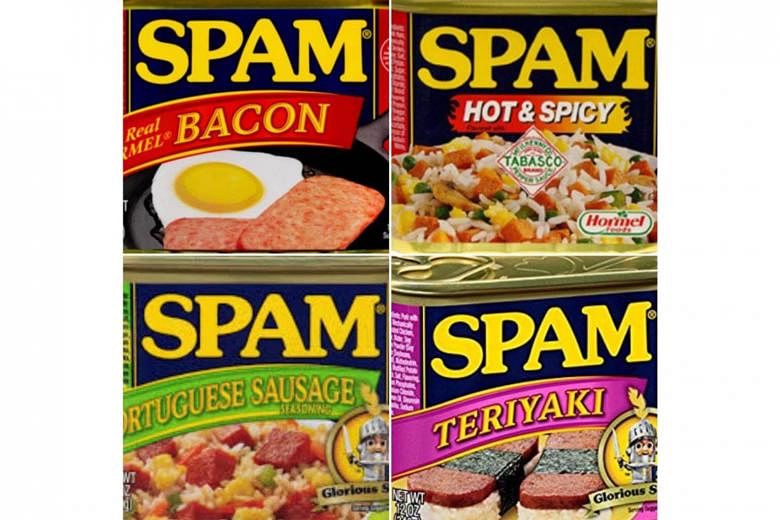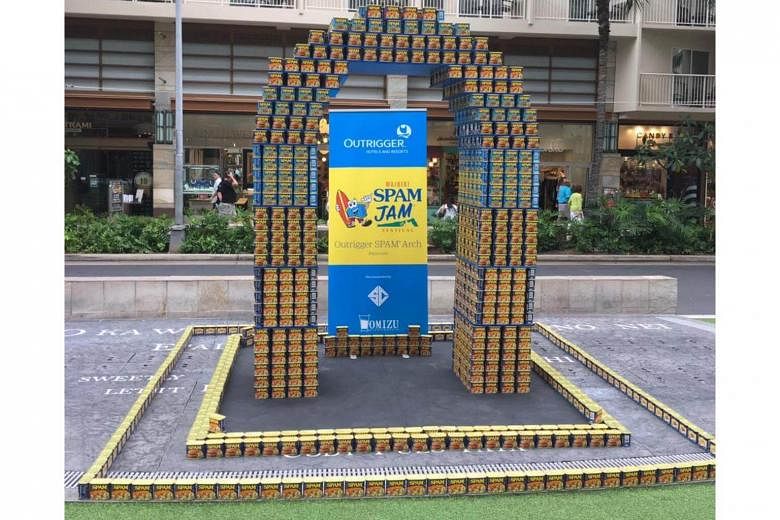HAWAII (GUARDIAN) - Not even the drizzle can deter the crowds unspooling along Hawaii's Waikiki Beach.
As late April showers fall on Kalakaua Avenue, the roads are lined three-deep with sunburnt tourists, surfer bros and silver-haired pensioners. Their colourful T-shirts, flower garlands and fancy dress costumes are soaked by rain, but eagerly they wait. Suddenly, a chorus of tiny ukuleles starts to play. The procession begins.
Are they waiting to pay homage to a visiting dignitary or religious leader? No. They are here to celebrate Hawaii's favourite food: the immortal luncheon meat called Spam.
I join snaking queues for seemingly endless food stalls, each dish more absurd than the last: Spam pizza, Spam fried rice, Spam crackers, Spam pho, deep-fried mac and cheese bites (with Spam) and, of course, Spam fritters. I spot some Spam-infused macadamia nuts, and a slab of grilled Spam atop sticky rice, doused in soya sauce and bound with seaweed: Spam sushi. There is even Spam dipped in chocolate.
Serious Spam fans are focused on buying up rare flavours such as Spam Mezclita , Spam Tocino and Spam Portuguese Sausage . Others snap selfies beneath a giant arch of Spam cans or gawp at a catamaran festooned with Spam tins.
Kids try their luck at the Spam wheel of fortune, hoping to take home a branded T-shirt or headphones.
I stumble into a king-sized Spam can made of foam, with human arms and legs sticking out. Inside is Honolulu Foodbank employee John Valdez.
"What would Hawaii be without Spam?" he shouts through the costume. "It would be boring."
Welcome to Spam Jam, the largest gathering of tinned pork enthusiasts on Earth. Today, I am one of 20,000 fans at the 15th annual event.
The residents of America's 50th state eat more Spam per capita than anywhere on earth, with "Hawaiian steak" found on five-star restaurant menus and at McDonald's. Last year, 8m cans were sold here - and that is just the regular-sized ones, not counting Spam Singles, Spam Spread or smaller tins. But it is not just Hawaii that adores Spam: in time for Spam's 80th birthday on July 5, global can sales topped eight billion.
In Britain, Spam is derided as fish bait, furniture varnish or gun grease. There have long been rumours that it contains pigs' lips, snouts, trotters and tail. In fact, it lists just a half-dozen ingredients: pork with ham ("Two cuts of the pig. One perfectly tender and juicy flavour"), water, salt, sugar, potato starch and sodium nitrite.
Spam's makers are keen to point out that there is no hidden "scrapings or useless bits of pork" and that it is all from the shoulder or rear. In fact, at 90 per cent pork, Spam rivals some luxury sausages. Yet, in the United Kingdom, its reputation is up there with Turkey Twizzlers , while its high salt and fat content make it the kind of processed food we now avoid for our health.
If Spam is known in Britain as a culinary punchline, why is it so popular across the Atlantic?
Unique flavour
In Austin, Minnesota, with a population of 24,716, all roads lead to Spam. "Spamtown USA", as it is sometimes known, is a cutesy, model version of a city, all straight lines and artificial lakes.
It was here in 1891 that George A. Hormel founded a family meatpacking firm that would one day become a Fortune 500 mainstay, employing one in six of Austin's inhabitants. "Hormel's got his feet sticking out the window again," schoolchildren used to say, when the porky odour floated out factory doors.
George's son, Jay Hormel, was a born opportunist: As a child, he would pay two cents for housewives' unwanted sink grease, then hawk it to his father's soap-making division for twice the price. In 1929, he succeeded George as president and soon came up with a way to make use of rarely butchered pork shoulder meat. He adapted a Napoleonic food preservation technique, adding salt and sodium nitrite to keep it pink, ward off botulism and, at the same time, making it indefinitely edible. By 1942, Hormel Foods was selling US$120 million worth of Spam a year.
Hormel-owned structures still dominate Austin's skyline. There is the stinky plant, rolling office blocks and the Hormel Institute , a biomedical research centre. The apex of the city's microscopic tourist industry is a newly revamped Spam museum, an Ikea-coloured time capsule of social, military and pop culture history.
With Spam print beanbags, touch-sensitive screens and a jungle gym, the museum is aimed at the meat lovers of tomorrow, but when I visit, it is also packed with elderly locals and Mormon missionaries. Inside, a bespectacled tour guide finds everything "Spamazing", including a production line of cans that whizz overhead like Scalextric.
"It is the meat that won the war," my guide cheerily informs me.
During World War II, Allied soldiers consumed 68,000 tonnes of Spam, but Jay Hormel was devastated by the hate mail he received.
"The language people use," he told the New Yorker in 1945. "If they think Spam is terrible, they ought to have eaten the bully beef we had in the last war."
Hormel died in 1954, before President Eisenhower sent a letter with a personal pardon.
"I ate my share of Spam… I'll even confess to a few unkind remarks about it," he wrote, on the firm's 75th anniversary in business. "But as former commander-in-chief, I believe I can still officially forgive you your only sin: sending us so much of it."
Today, the Spam museum is hosting its first wedding. Tying the knot are an eccentric British couple, Anne Mousley, 33, and Mark Benson, 42. A smiley care worker from Liverpool, Benson recently changed his middle name by deed poll to I Love Spam. His grandfather worked in Liverpool's Spam factory after the war. No prizes for guessing the wedding buffet.
"It's like nothing else," says Benson of his favourite food, which he eats at least twice a week. "Bit of a bacon flavour, bit of a porky flavour. It's totally unique."
Spam aficionados of such calibre are rare, although I do learn of one Nebraskan man who in 2007 survived a 30-day Spam-only eating challenge.
Meanwhile, in South Korea, second only to America for Spam consumption, profits are booming.
During the lunar new year, Spam is given as a gift, and budae jjigae , a Spam-infused army stew from the second world war, remains popular.
I learn that island territories such as Guam and Micronesia see Spam as a life-saver. During extreme weather, Spam's limitless shelf life makes it a Pacific Islander's best friend.
Later, I speak to a wild-haired Spam celebrity in rural Alaska, known as Mr Whitekeys. For 26 years, he ran a Spam-themed bar, complete with "frequent Spammer" cards - buy 10 meals, get one free.
"If you want meat, you gotta have Spam," he says via Skype. Why?
"You can't get fresh supplies in large amounts and half the time you don't have refrigeration."
Back in sunny Hawaii, "breakfast beers" are noisily slammed on a plastic folding table.
Almost 5km from Waikiki Beach, I am mingling with professional chefs at the esteemed Kaka'ako farmers' market, surrounded by organic produce and artisanal pasta.
Keen to know what islanders really think of Spam, I talk to chef Mark "Gooch" Noguchi, 43, who runs the Pili Group , a culinary movement based around healthy, sustainable food. The opposite, one would assume, of Spam.
But "I love, love, love Spam", Noguchi tells me, unprompted, between swigs of beer, dressed in shorts, flip-flops and a loud flowery shirt.
"We grew up on it," he explains, passing me a pan-fresh beef taco.
"I remember when I was cooking in New York, other chefs would joke with me, like, 'Ha, you guys eat Spam,'" he says. "But our parents had gone through the second world war. The big joke among local people is that if you visit your grandparents and look downstairs, there's six cases of toilet paper, four cases of paper towels and three cases of Spam."
In Hawaii, Spam is the cement that bonds its many cultures - from Japanese, Filipino and Hawaiian, through to mainland United States. Noguchi proudly boasts that locals can tell Spam from its canned-pork competitors Tulip and Treet.
Elsewhere, Spam is slowly being appropriated by hipster culture, just like scotch eggs and avocado before it. In London's Soho, Jinjuu restaurant makes a Spamarita cocktail, mixing Spam-infused Ocho tequila with mezcal, pineapple, citrus, mandarin orange and agave nectar. And Saint Marc, an upscale restaurant in Huntington Beach, California, has a hidden Spam speakeasy known as the Blind Pig.
"It's revered," says Nina Pullella, 36, a chef I meet at Kaka'ako market. "I think it's the challenge of taking a can off the shelf - this strange food from the second world war - and doing something spectacular."
Pullella is a vegan, from New Jersey via Italy, yet she still oozes praise for Spam as an ingredient.
After three hours at the market, I find just one person down on Spam. And she will not talk on record. "Are you kidding? I'll have the whole island on my back," she whispers.
Night falls on Waikiki Beach. As the raindrops evaporate, a female rock band loudly tests the suspension of a flatbed stage. There is a snaking queue for OnoPops , an ice-cream company that flogs a Spam-based popsicle.
"It's a heartstrings thing," explains owner Josh Lanthier-Welch, 46, a stout man with a goatee. Though a Spam devotee, he warns of the dangers of excess: "The Spam musubi (sushi) is a symbol of what's wrong with the local diet. It is so beloved, but living on Spam, white rice and nori will kill you."
As the festival comes to a close, I decide to break my 20-plus years of Spam abstinence (I have not touched the stuff since childhood). I am handed a skewer of cold cubed Spam and crunchy vegetables. I sink my teeth into the soft meat and am transported back to my youth. The salty, pork-ish flavour wafts up my nostrils. I feel dirty and a little bit sick.
Next, I try a hot Spam katsu sandwich from Hula Grill. I take a small bite. Then a larger one. It has a deep, smoky bacon flavour, offset by rich katsu sauce. It is, I am almost embarrassed to say, tremendous. Spam tempura fries, Spam corn dogs and Spam dim sum soon follow.
As I chew, I wonder if Spam deserves its reputation. Perhaps Brits just lack the imagination to cook Spam right. Or maybe, like Kit Kats in Japan or David Hasselhoff's mega-stardom in Germany, Spam should simply remain a pop culture anomaly - the American Marmite that one either loves or hates.
Spam fritters
INGREDIENTS
340g Spam
150g plain flour
225ml cold water
3 Tbsp olive oil
Buttered roll (optional)
METHOD
1. Cut the Spam lengthways into six thick slices.
2. Put the flour in a mixing bowl and slowly introduce the water, whisking, until you have a smooth batter.
3. Heat the oil in a large frying pan. Dip each slice of Spam in the batter mix, shake to drain off any excess and lay in the hot pan. When it is golden and crisp on one side, flip and repeat until it is brown and crisp on both sides.
4. Serve in a buttered roll, if desired, with chips and peas on the side.
Serves three




